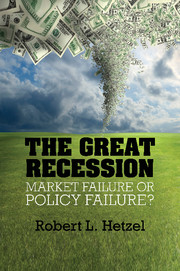Book contents
- Frontmatter
- Contents
- Figures
- Tables
- Preface
- One The 2008–2009 Recession
- Two Recessions
- Three The Great Contraction
- Four Monetary Policy and Bank Runs in the Great Depression
- Five Vigorous Recovery and Relapse
- Six Interwar International Monetary Experiments
- Seven Identifying the Shocks that Cause Recessions
- Eight From Stop-Go to the Great Moderation
- Nine Controlling Bank Risk Taking
- Ten The Housing Crash
- Eleven Bubble Trouble
- Twelve What Caused the Great Recession of 2008–2009?
- Thirteen What Caused the Great Leverage Collapse?
- Fourteen The Distinctions Between Credit, Monetary, and Liquidity Policy
- Fifteen Fed Market Interventions
- Sixteen Evaluating Policy
- Seventeen The Business Cycle
- Eighteen Why Is Learning So Hard?
- Nineteen How Should Society Regulate Capitalism?
- Postscript
- Bibliography
- Index
- References
Sixteen - Evaluating Policy
What Are the Relevant Counterfactuals?
Published online by Cambridge University Press: 05 May 2012
- Frontmatter
- Contents
- Figures
- Tables
- Preface
- One The 2008–2009 Recession
- Two Recessions
- Three The Great Contraction
- Four Monetary Policy and Bank Runs in the Great Depression
- Five Vigorous Recovery and Relapse
- Six Interwar International Monetary Experiments
- Seven Identifying the Shocks that Cause Recessions
- Eight From Stop-Go to the Great Moderation
- Nine Controlling Bank Risk Taking
- Ten The Housing Crash
- Eleven Bubble Trouble
- Twelve What Caused the Great Recession of 2008–2009?
- Thirteen What Caused the Great Leverage Collapse?
- Fourteen The Distinctions Between Credit, Monetary, and Liquidity Policy
- Fifteen Fed Market Interventions
- Sixteen Evaluating Policy
- Seventeen The Business Cycle
- Eighteen Why Is Learning So Hard?
- Nineteen How Should Society Regulate Capitalism?
- Postscript
- Bibliography
- Index
- References
Summary
Popular discourse explains the 2008–2009 recession by reference to the Depression. In the Depression, supposedly, the failure of speculative investments undertaken by banks threatened bank solvency. Panicked depositors ran the banks; the Fed did nothing; the financial system collapsed; and the economy crashed. The story then shifts to the present in which again risky investments wounded banks, which restricted credit and supposedly pushed the economy into recession. This time, however, governments and central banks saved the banks from a panicked run and prevented the recurrence of the Great Depression.
A New York Times (2010a) editorial, which concerned the Obama administration’s proposed tax on large banks to generate revenue in an amount equal to the $120 billion of TARP money invested in banks, expressed this view of the 2008–2009 recession:
[T]he crisis spawned by banks’ recklessness cost the country a lot more than $120 billion. Any calculation must also include the deepest recession since the 1930s and the loss of more than seven million jobs…. The crisis occurred because banks that had grown too big to fail came too close to failure – driven by a reckless pursuit of risk and profit. Credit froze, and the government was forced to put enormous public resources at their disposal to keep them afloat.
- Type
- Chapter
- Information
- The Great RecessionMarket Failure or Policy Failure?, pp. 300 - 318Publisher: Cambridge University PressPrint publication year: 2012

